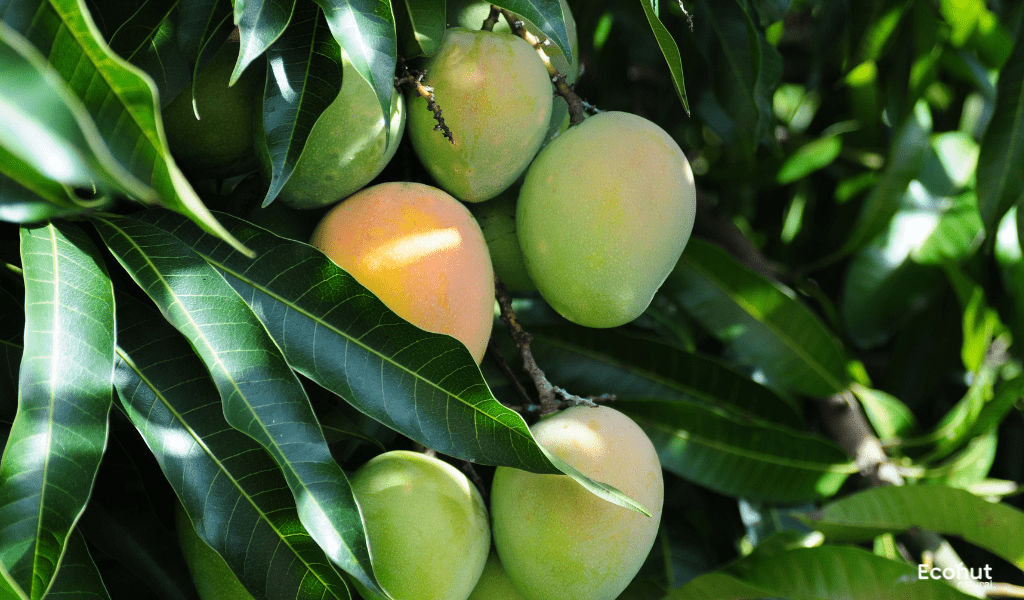Mangos are known as the “king of fruits” for a variety of health reasons, including their sweet, juicy flavor. Ayurvedic medicine places great importance on the mango, or aam, Mangifera indica. It is a member of the 30 species-strong family Anacardiaceae and genus Mangifera.
India is well-known for its vast array of mango types, including the Kesar variety in Gujarat, the Dasheri variety in Lucknow, the Badami variety in Karnataka, and the Alphonso variety in Ratnagiri, to mention a few. Mangoes are beneficial to our health and taste buds.
Description
The mango tree is an evergreen, upright tree that can reach a height of 20 to 45 meters. Its sturdy trunk and oval, upright crown have a dome form. Mango trees have a lengthy lifespan-between 250 and 300 years-and produce fruit. This tree’s linear, oblong, lanceolate, elliptical, pointed leaves are arranged in a spiral pattern on branches and offer a calming scent.
Botanical Name:
Mangifera indica
Family:
Anacardiaceae
Leaves:
Mango leaves are a striking characteristic, shaped like a big lance. They are placed along the branches in an alternating pattern to maximize the amount of sunlight captured. When leaves are young, they frequently have a pinkish-red hue before developing into a lustrous, dark green hue.
Flowers:
Clusters of fragrant flowers are produced by mango trees. The panicles that these inflorescences are arranged in are branching structures that have the capacity to support a large number of individual blooms.
Fruit:
The fruit of the mango tree is without a doubt its most valuable component. There are three main portions to it.
Stem:
The stem, often known as the trunk, gives the mango tree as a whole its structural support. Some variants of this robust and dense structure can reach heights of up to thirty meters, or one hundred feet. When a tree is young, its outside bark is usually smooth and grayish; as it ages, it becomes rougher and darker.
Habitat:
The mango originated in South Asia and has been farmed for thousands of years. It is found all over the world in warm, tropical and subtropical regions. India and China are the two countries that cultivate the majority of the world’s mango crop. Additionally, South Korea, Bangladesh, Pakistan, Central America, and West and Central Africa are home to it. This fruit is also susceptible to many other diseases.
Parts Used:
- Stem bark
- Seed kernel
- Leaf
- Flower
Dosage:
- Juice – 10 – 20 ml
- Seed Powder – 3 – 6 gm
- Decoction – 50 -100 ml
Chemical Constituents
Pectins and cellulose, two types of structural carbohydrates, are also present in mango fruit. Lysine, leucine, cysteine, valine, arginine, phenylalanine, and methionine are the main amino acids. Ripeness causes a rise in the lipid content, especially in omega-3 and omega-6 fatty acids.
Other Language Names of Mango (Mangifera indica)
Hindi name – Aam
English name – Mango
Sanskrit name – Bhringabeeshta, Parapushta, Pikabandhava,Aamra, Sahakara, Madhavadrum, Rasala, Madhuphala, Madhuli etc.
Scientific Classification
| Kingdom | Plantae |
| Order | Sapindales |
| Family | Anacardiaceae |
Ayurvedic Properties
Hindi/Sanskrit
- Rasa -Kashaya
- Guna -Laghu
- Virya -Sheet
- Vipaka -Katu
English
- Taste -Astringent
- Physical Property-Light
- Potency- Cold
- Metabolic Property (After Digestion)-Sweet
Mango (Mangifera indica) Uses
Fresh fruit:
This is how mangoes are most commonly consumed. Sliced, they can be eaten on their own, in salads, blended drinks, or alongside yogurt.
Drinks:
Mangoes are excellent in juices, smoothies, lassi (a drink made with yogurt), and even in mixed drinks like margaritas.
Pickles and chutneys:
Mangoes are excellent in juices, smoothies, lassi (a drink made with yogurt), and even in mixed drinks like margaritas.
Culinary uses:
To give savory foods a sweet and tangy taste, mangoes can be grilled, added to curries, or used in chutneys.
Mango (Mangifera indica) Benefits
Combats the onset of chronic illnesses:
Mangiferin, a polyphenol present in many plants but particularly high concentrations in mango (Mangifera indica) plants and leaves, is responsible for a number of possible health advantages of mango leaves. The ingredient is an antimicrobial and has anti-inflammatory qualities. This makes it useful in the treatment of heart disease, diabetes, cancers, and disorders related to the digestion of fat.
Diabetes:
According to research on animals, the mango tree’s delicate leaves include tannins and phytochemicals known as anthocyanidins that may be able to lower blood sugar levels.
Get rid of kidney and gallstones:
Mango leaves aid in the dissolution of kidney and gallstones. After being dried in the shade, grind the mango leaves into a fine powder. Stir in the powder and let it sit overnight. For kidney stone dissolution, drink this mixture every day.
Protect Against Abnormal Fat Gain:
In tissue cells, mango leaf extract can prevent the accumulation of fat. The extracts’ interference with fat metabolism helps prevent fat gain, diabetes, obesity, and cardiac problems while also aiding in the management of metabolic syndrome symptoms.
Mango (Mangifera indica) Side Effects
Digestive issues:
Because of their high fiber content, eating too many mangoes can cause gas, bloating, cramps, and even diarrhea.
Weight gain:
Mangoes have calories and are naturally sweet. Although excessive consumption is not necessarily harmful, it can lead to weight gain.
Allergic reactions:
Mango allergies can cause runny noses, stomachaches, throat irritation, and sneezing in certain individuals. Some mango types may experience this more frequently.
Blood sugar spikes:
Mangoes naturally contain a lot of sugar, specifically fructose. Blood sugar surges may result from this, particularly in those with prediabetes or diabetes.
Interaction with medications:
Mangoes have the unusual potential to interfere with several drugs.
Don’t miss: Nagkesar (Mesua ferrea) – Uses, Properties, Benefits & side Effects
Conclusion
The magnificent mango tree, Mangifera indica, is very beneficial and useful. This adaptable tree is essential to many facets of both human existence and the natural world, from fostering nourishment and health to providing for livelihoods. The mango tree connects the complex webs of human existence and the natural world, symbolizing abundance and vigor through its food richness, culinary flexibility, economic relevance, and ecological contributions.
FAQS
What advantages does Mangifera indica have for health?
Plant parts are utilized for treating diarrhea, dysentery, anemia, asthma, bronchitis, cough, hypertension, insomnia, rheumatism, toothache, leucorrhoea, hemorrhage, and piles. They are also employed as a dentrifrice, antiseptic, astringent, diaphoretic, stomachic, vermifuge, tonic, laxative, and diuretic.
What uses are there for mangoes?
Antioxidants, vitamins, and minerals found in mangoes can significantly improve health. For example, vitamin K helps to prevent anemia and facilitates the effective production of blood clots. Additionally, it is necessary to keep your bones strong.
Do mango leaves benefit the liver?
Since many families utilize this leaf as their daily drinking water rather than filtered water, many of them are extremely familiar with it. You can drink it hot or cold after giving it a quick wash and boiling. The water has a cooling, refreshing, and diuretic impact in addition to helping to cool the liver.

